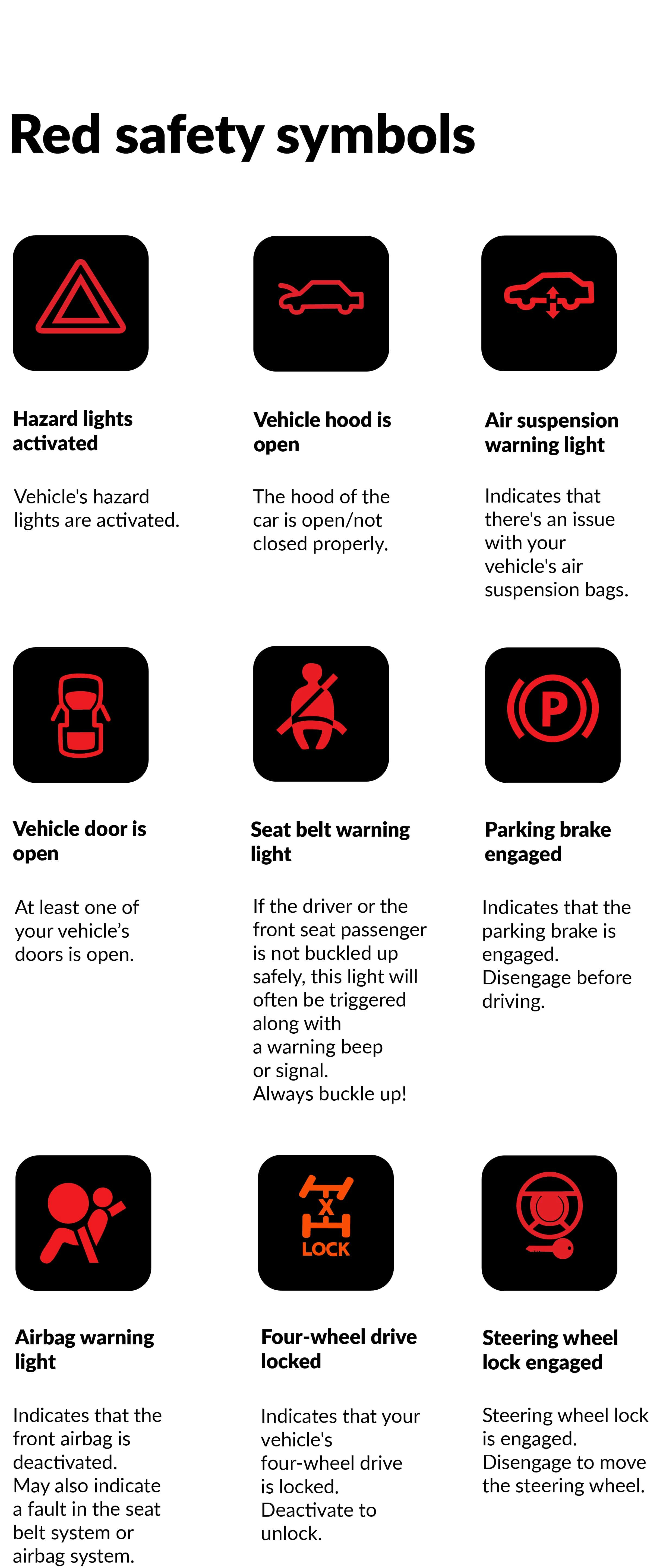
Dashboard Lights Explained: Meaning of Different Symbols & Indicators
Whether you have a brand-new car or a tried-and-true used vehicle, every once in a while you’ll see one of your dashboard symbols light up while you’re driving. Although you may know what a few of the symbols mean, it’s likely that some of those warning lights may be mysterious and concerning. In some cases, dashboard lights may just be reminding you to schedule service or check some system in your car before something more serious occurs. In other cases, they serve as an important warning to act as soon as possible.
Today, we will go through the most common and important dashboard warning lights, what they mean, and which ones will require you to take action. You’ll also find complete lists of all lights at the end of the article.
The Most Common Warning Symbols on Your Car’s Dashboard
The following dozen dashboard warning lights are some of the most commonly seen by drivers, and it’s particularly important that you understand what they are telling you.
In some cases, they may just be reminding you to schedule service or check some system in your car before something more serious occurs. In other cases, they serve as an important warning to act as soon as possible.
Fuel Warning Light

This is a well-known one – the low fuel warning light. Usually, this light comes on when your fuel tank is dangerously near empty. Although some drivers ignore the low fuel warning for dozens of miles, it’s more prudent to start looking for a gas station as soon as this light is triggered. Remember, stopping for gas before you hit empty will save you a lot of stress and time should you run out of fuel on the road.
Oil Indicator Light

Besides gasoline, having the right level of oil in your car may be the next most important fluid to keep things running smoothly. Good quality and proper quantity of oil serve to keep your engine lubricated well and functioning at its peak. If your oil warning light goes on, this may indicate one of several things. It may be time to schedule a regular oil change or be prompting you to add oil to your vehicle. This dashboard light may also be triggered if you need to repair an oil pump that has malfunctioned and is no longer circulating enough oil throughout your vehicle. Regardless of the issue, this problem should be addressed as soon as possible.
Tire Pressure Light

When your parents were young, it’s likely that their families used an old-fashioned tire pressure gauge to periodically check that car tires were inflated properly. However, these days, most vehicles can monitor this automatically. If your tire pressure warning light is on, it means that one or more of your tires may require more air. Although this is often not an emergency, be sure to check and refill your tires as soon as possible. It may indicate a slow leak caused by a nail lodged in your tire or serve as a warning that you may be dealing with a flat tire in the near future. If you drive with incorrect tire pressure for a long period of time, it can cause additional problems in your car as well as result in poor gas mileage.
Check Engine Light

The “check engine” warning light may be hard to interpret, this is due to the fact that a wide variety of issues may trigger this warning. On one hand, it may require a simple fix such as tightening your gas cap. If your gas cap Is loose, fuel may evaporate and trigger your engine light.
On the other hand, the warning light could indicate a serious problem that requires immediate attention. When your check engine light appears, be sure to have a mechanic evaluate the problem as soon as possible. Many auto supply stores can help you diagnose the light at no charge.
Battery Warning Light

Although this dashboard symbol is symbolized by a battery, problems that trigger this warning may have to do with a car’s overall electrical system in addition to battery issues. When this light appears, pay close attention to the electrical systems in your vehicle. For example, if your headlights seem dim, you may require a new battery. Other electrical systems and alternator problems may require a professional to diagnose and repair.
Seat Belt Indicator Light

The seatbelt warning light may be one of the most important in your car. If the driver or the front seat passenger is not buckled up safely, this light will often be triggered along with a warning beep or signal.
In most states, wearing a seatbelt is required by law. Be sure that all your passengers stay buckled anytime your vehicle is moving. The use of seat belts significantly reduces injury and death in car-related accidents.
Temperature Warning Light

Although your vehicle probably has a temperature gauge that ranges from cold to hot, it’s unlikely that you check it frequently. Vehicle manufacturers realize this and, therefore, have included a temperature warning light.
When this light is triggered, it means that your engine is overheating, which can be a dangerous situation. Most likely this is caused by a low coolant level or some other problem with the cooling system in your car. Be sure to have a professional mechanic explore the reason for this problem as soon as possible.
Brake Warning Light

The brake warning light can have multiple meanings, which can be confusing for drivers. It will be on if you have engaged your parking brake, for example, and is simply reminding you to disengage it before driving.
However, if your parking brake is not on and your brake light still is, this may indicate a problem with your brake pads, discs, or calipers. It can also be triggered when your brake fuel is low or your ABS system is not working. The inability to stop a car is a dangerous situation, so if your brake light is on, be sure to find the cause immediately.
Cruise Control Indicator Light

Usually, the cruise control light is not a warning light like many of the others on this list. Instead, it simply reminds you that your cruise control feature is engaged and that you can simply set your car to maintain a constant speed. However, in some cases, if the light isn’t green, it can indicate a problem with the system.
Traction Control Light

Driving during inclement weather conditions can be hazardous. Fortunately, many car manufacturers have added features to help make winter and rainy driving a little safer. The traction control indicator symbol signifies that a car’s traction control system is on. Working with an anti-lock brake system (ABS), the traction control can detect when one wheel is spinning faster and slipping. At this time, the system triggers the braking system until the car regains traction.
Anti-lock Brake Light

ABS stands for anti-lock brakes, and when this warning light appears, it indicates a problem with the car’s ABS system. Although your regular brakes will continue working even without your ABS, it’s important to get this problem examined by a professional at your earliest convenience. This is especially important if you’ll be driving in wet, icy, or snowy conditions when an ABS system provides an extra layer of safety support to keep your tires in contact with the road.
All Warning Symbols

All Red Safety Symbols

That’s it!
The warning lights on your car’s dashboard are designed to help you drive safely and reduce emergency problems on the road. Be sure you pay attention to them when they appear. If you’re not certain of their meaning, consult your driver’s manual for more details.

Avoid beginner mistakes with expert advice
Build road test confidence and reduce anxiety
Make at-home lessons a success with our parent guide
Recommended articles
Ace your DMV test, guaranteed
Want to Be the Top School in Your Area?
- Simple & automated admin
- More time for teaching
- #1 learning materials for students


